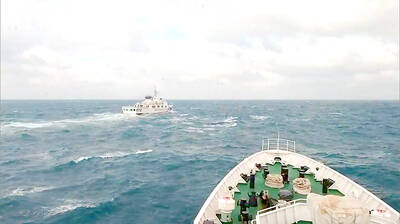American cattle are eating chicken litter, cattle blood and restaurant leftovers that could help transmit mad cow disease, gaps in the US defense against the disease that the Bush administration promised almost 18 months ago to close.
"Once the cameras were turned off, and the media coverage dissipated, then it's been business as usual: no real reform, just keep feeding slaughterhouse waste," said John Stauber, an activist and co-author of Mad Cow USA: Could the Nightmare Happen Here?
"The entire US policy is designed to protect the livestock industry's access to slaughterhouse waste as cheap feed," he said.
The government is now investigating another possible case of bovine spongiform encephalopathy (BSE) or mad cow disease, in the US.
The Food and Drug Administration (FDA) promised to tighten feed rules shortly after the first case of mad cow disease was confirmed in the US, in a Washington state cow in December 2003.
"Today we are bolstering our BSE firewalls to protect the public," Mark McClellan, then-FDA commissioner, said on Jan. 26 last year.
The FDA said it would ban blood, poultry litter and restaurant plate waste from cattle feed and require feed mills to use separate equipment to make cattle feed. Chicken litter is ground cover for the birds that absorbs manure, spilled feed and feathers.
However, last July, the FDA scrapped the restrictions. McClellan's replacement, Lester Crawford, said an international team of experts assembled by the Agriculture Department was recommending even stronger rules, and the FDA would produce new restrictions in line with those recommendations.
Today, the FDA still has not done what it promised to do. The agency declined interviews, saying in a statement only that no timeline exists for new restrictions.
"It's just a lot of talk," said Representative Rosa DeLauro, a Democrat, a senior House Democrat on food and farm issues.
"It's a lot of talk, a lot of press releases, and no action," she said.
Ground-up cattle remains left over from slaughtering operations were used as protein in cattle feed until 1997, when an outbreak of mad cow cases in Britain prompted the US to order the feed industry to quit doing it.
Unlike Britain, however, the US ban has exceptions. For example, it's legal to put ground-up cattle remains in chicken feed. Feed that spills from cages mixes with chicken waste on the ground, then is swept up for use in cattle feed.
Scientists believe the BSE protein will survive the feed-making process and may even survive the trip through a chicken's gut.
That amounts to the legal feeding of some cattle protein back to cattle, said Linda Detwiler, a former Agriculture Department veterinarian who worked on mad cow disease for several years.
"I would stipulate it's probably not a real common thing, and the amounts are pretty small,"she said.

Taiwan is gearing up to celebrate the New Year at events across the country, headlined by the annual countdown and Taipei 101 fireworks display at midnight. Many of the events are to be livesteamed online. See below for lineups and links: Taipei Taipei’s New Year’s Party 2026 is to begin at 7pm and run until 1am, with the theme “Sailing to the Future.” South Korean girl group KARA is headlining the concert at Taipei City Hall Plaza, with additional performances by Amber An (安心亞), Nick Chou (周湯豪), hip-hop trio Nine One One (玖壹壹), Bii (畢書盡), girl group Genblue (幻藍小熊) and more. The festivities are to

Auckland rang in 2026 with a downtown fireworks display launched from New Zealand’s tallest structure, Sky Tower, making it the first major city to greet the new year at a celebration dampened by rain, while crowds in Taipei braved the elements to watch Taipei 101’s display. South Pacific countries are the first to bid farewell to 2025. Clocks struck midnight in Auckland, with a population of 1.7 million, 18 hours before the famous ball was to drop in New York’s Times Square. The five-minute display involved 3,500 fireworks launched from the 240m Sky Tower. Smaller community events were canceled across New Zealand’s

The Ministry of Foreign Affairs (MOFA) yesterday said it is closely monitoring developments in Venezuela, and would continue to cooperate with democratic allies and work together for regional and global security, stability, and prosperity. The remarks came after the US on Saturday launched a series of airstrikes in Venezuela and kidnapped Venezuelan President Nicolas Maduro, who was later flown to New York along with his wife. The pair face US charges related to drug trafficking and alleged cooperation with gangs designated as terrorist organizations. Maduro has denied the allegations. The ministry said that it is closely monitoring the political and economic situation

‘SLICING METHOD’: In the event of a blockade, the China Coast Guard would intercept Taiwanese ships while its navy would seek to deter foreign intervention China’s military drills around Taiwan this week signaled potential strategies to cut the nation off from energy supplies and foreign military assistance, a US think tank report said. The Chinese People’s Liberation Army (PLA) conducted what it called “Justice Mission 2025” exercises from Monday to Tuesday in five maritime zones and airspace around Taiwan, calling them a warning to “Taiwanese independence” forces. In a report released on Wednesday, the Institute for the Study of War said the exercises effectively simulated blocking shipping routes to major port cities, including Kaohsiung, Keelung and Hualien. Taiwan would be highly vulnerable under such a blockade, because it